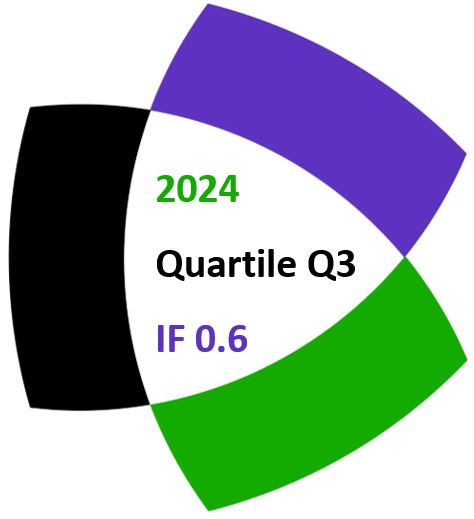Sure Köme and Hafize Kirik
Notes on Number Theory and Discrete Mathematics
Print ISSN 1310–5132, Online ISSN 2367-8275
Volume 26, 2020, Number 4, Pages 173–186
DOI: 10.7546/nntdm.2020.26.4.173-186
Full paper (PDF, 156 Kb)
Details
Authors and affiliations
Sure Köme ![]()
Department of Mathematics, Nevşehir Hacı Bektaş Veli University, Turkey
Hafize Kirik ![]()
Department of Mathematics, Nevşehir Hacı Bektaş Veli University, Turkey
Abstract
This study introduces the modified generalized Fibonacci and Lucas 2k−ions which are the generalizations of several quaternions, octonions and higher order dimensional algebras. We give the generating functions, the Binet formulas and well-known identities such as Catalan’s identity and Cassini’s identity for the modified generalized Fibonacci and Lucas 2k−ions.
Keywords
- Modified generalized Fibonacci sequence
- Modified generalized Lucas sequence
- Recurrence relations
- 2k−ions
2010 Mathematics Subject Classification
- 11B39
- 05A15
References
- Bilgici, G. (2014). Two generalizations of Lucas sequences. Applied Mathematical Sciences, 245, 526–538.
- Bilgici, G., Tokeşer, Ü., & Ünal, Z. (2017). Fibonacci and Lucas sedenions. Journal of Integer Sequences, 20(2), 3.
- Biss, D. K., Dugger, D., & Isaksen, D. C. (2008). Large annihilators in Cayley−Dickson algebras. Communications in Algebra, 36(2), 632–664.
- Çimen, C. B., & İpek, A. (2017). On Jacobsthal and Jacobsthal–Lucas octonions. Mediterranean Journal of Mathematics, 14(2), 37.
- Edson, M., & Yayenie, O. (2009). A New Generalization of Fibonacci Sequence & Extended Binet’s Formula. Integers, 9 (6), 639–654.
- Falcón, S., & Plaza, Á. (2007). The k−Fibonacci sequence and the Pascal 2-triangle. Chaos, Solitons & Fractals, 33(1), 38–49.
- Göcen, M., & Soykan, Y. (2019). Horadam 2k−ions. Konuralp Journal of Mathematics, 7(2), 492–501.
- Gül, K. (2018). On k−Fibonacci and k−Lucas Trigintaduonions. International Journal of Contemporary Mathematical Sciences, 13(1), 1–10.
- Halıcı, S. (2012). On Fibonacci quaternions. Adv. Appl. Clifford Algebras, 22(2), 321–327.
- Horadam, A. F. (1963). Complex Fibonacci numbers and Fibonacci quaternions. The American Mathematical Monthly, 70(3), 289–291.
- Keçilioğlu, O., & Akkuş, I. (2015). The Fibonacci octonions. Advances in Applied Clifford Algebras, 25(1), 151–158.
- Koshy, T. (2001). Fibonacci and Lucas Numbers with Applications, John Wiley & Sons.
- Köme, S., Köme, C., & Yazlık, Y. (2019). Modified generalized Fibonacci and Lucas quaternions. Journal of Science and Arts, 19(1), 49–60.
- Ramirez, J. L. (2015). Some combinatorial properties of the k−Fibonacci and the k−Lucas quaternions. Analele Universitatii “Ovidius” Constanta-Seria Matematica, 23(2), 201–212.
- Szynal-Liana, A., & Włoch, I. (2016). The Pell quaternions and the Pell octonions. Advances in Applied Clifford Algebras, 26(1), 435–440.
- Szynal-Liana, A., & Włoch, I. (2016). A note on Jacobsthal quaternions. Advances in Applied Clifford Algebras, 26(1), 441–447.
- Tan, E., Yılmaz, S., & Şahin, M. (2016). On a new generalization of Fibonacci quaternions. Chaos, Solitons & Fractals, 82, 1–4.
- Tan, E., Yılmaz, S., & Şahin, M. (2016). A note on bi-periodic Fibonacci and Lucas quaternions. Chaos, Solitons & Fractals, 85, 138–142.
- Yayenie, O. (2011). A note on generalized Fibonacci sequences. Applied Mathematics and Computation, 217 (12), 5603–5611.
- Yazlık, Y., Köme, C., & Madhusudanan, V. (2018). A new generalization of Fibonacci and Lucas p−numbers. Journal of Computational Analysis and Applications, 25(4), 657–669.
- Yazlık, Y., & Taşkara, N. (2012). A note on generalized k-Horadam sequence. Computers & Mathematics with Applications, 63(1), 36–41.
- Yılmaz, N., Yazlık, Y., & Taşkara N. (2016). The bi-periodic Fibonacci octonions (arXiv:1603.00681).
- Yılmaz, N., Yazlık, Y., & Taşkara, N. (2017). On the bi-periodic Lucas octonions. Advances in Applied Clifford Algebras, 27(2), 1927–1937.
Related papers
Cite this paper
Köme, S., & Kirik, H. (2020). On the generalized Fibonacci and Lucas 2k−ions. Notes on Number Theory and Discrete Mathematics, 26 (4), 173-186, DOI: 10.7546/nntdm.2020.26.4.173-186.


